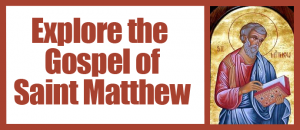 In the last issue of this article, the Gospel of Matthew has a particular fivefold structure to its narrative that is similar to the five books of the Torah, the Pentateuch. The theme expressed in this structure also shows up in particular details. For example, the first of the five blocks in Matthew begins with Jesus going up the mountain to pray. This sets the stage for what follows in chapters 5 through 7, namely the Sermon on the Mount. Matthew is the only gospel that says that Jesus taught from a mountain. Jesus is like Moses, a new Moses, revealing God’s will from a mountain, a new Sinai.
In the last issue of this article, the Gospel of Matthew has a particular fivefold structure to its narrative that is similar to the five books of the Torah, the Pentateuch. The theme expressed in this structure also shows up in particular details. For example, the first of the five blocks in Matthew begins with Jesus going up the mountain to pray. This sets the stage for what follows in chapters 5 through 7, namely the Sermon on the Mount. Matthew is the only gospel that says that Jesus taught from a mountain. Jesus is like Moses, a new Moses, revealing God’s will from a mountain, a new Sinai.
Connections with Moses and the exodus also appear in Matthew’s story of Jesus’ birth. After presenting a genealogy that underlines Jesus’ origin in Israel’s heritage going back to Abraham, the first block is dominated by King Herod’s plot to kill the newborn king of the Jews. Even the story of the wise men is integrated into this theme. Herod’s behavior echoes Pharaoh’s in the story of the exodus, including the order to kill Jewish infants. Other details in first-century Jewish versions of the story of Moses’ birth also shape Matthew’s birth story. It functions as an overture to the gospel, announcing its central theme: Jesus is a new Moses leading a new exodus from a new pharaoh into a new way of life.
You will recall that the Eastern Church truly calls the Resurrection of Christ the Pasch, the Jewish term used for Passover. You will also recall that Moses was the one who led the Jewish people our of Egypt and through whose intercession God’s Angel of Death passed over all the homes of the Jews that had the blood of a lamb smeared on the doorpost. When we pray Matins (Morning Prayer) on Easter Morning, our prayers are filled with images of the Resurrection being the new Exodus and Christ, therefore, being the new Moses.
Matthew’s fivefold structure and the theme it expresses indicates the gospel’s deep roots within Judaism. Of course, the other gospels and the New Testament are also rooted in Judaism, but Matthew emphasizes this more. The author of this gospel structured it in this manner on purpose since he wanted to signal to the potential Jewish converts that Jesus is the new Moses and that God is calling them to form a new, more genuine, community.
Not counting allusions or echoes, the author of Matthew quotes the Jewish Bible 40 times with an explicit phrase such as It is written and another 21 times without such a phrase. Matthew affirms the eternal validity of the law and the prophets, designations for sections of the Jewish Bible in his time.
As a preparation for the next article on Matthew’s Gospel, read chapter 5, verses 17-18. That will make the above statement much more understandable
